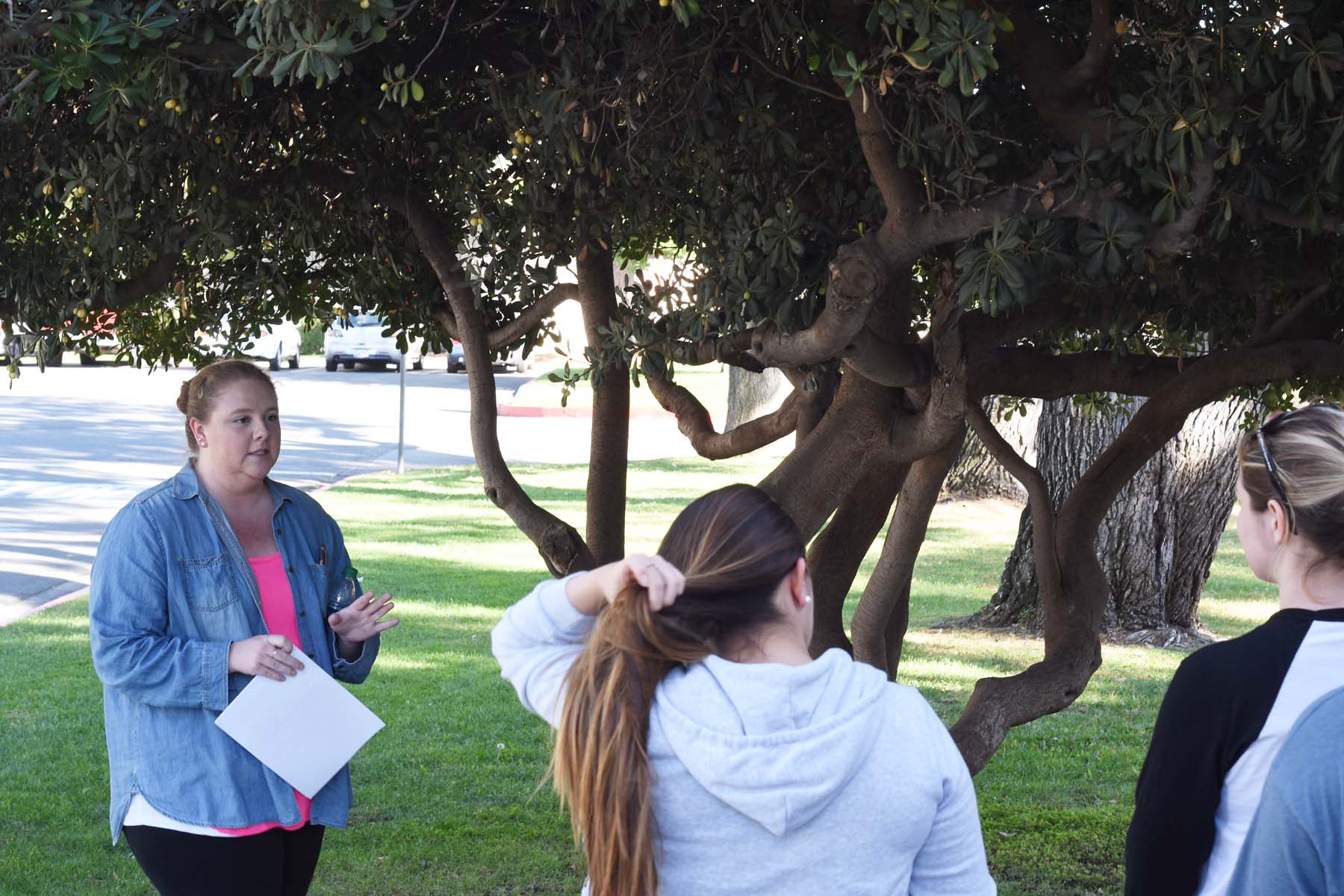University of Redlands Emergency Alert System
Alert Received: . For more information, visit: https://www.redlands.edu/alert/
University of Redlands
- Home
- Trees
- Species Accounts
- Japanese Pittosporum
Classification
Common Name: Japanese Pittosporum
Scientific Name: Pittosporum tobira
Family: Pittosporaceae
Identification
Habit: The Japanese Pittosporum is a smaller tree that only grows to about 15 feet high with a rounded top. Sensitivity to light is a key factor in their growth. If grown in full sun they will be smaller and more compact, similar to a hedge (figure 1). Whereas, if they are grown in the shade, the Japanese Pittosporum grows more like a traditional tree1 (figure 2). If grown in containers, they can be kept around 4 feet in height 2.

Figure 1: Image of Japanese pittosporum in hedge form

Figure 2: Japanese pittosporum in tree form.
https://davesgarden.com/guides/pf/showimage/410272/
Leaves: The vibrant, dark green, oval shaped leaves are shiny on one side while more matte on the other with an average length of 1.5 inches1. However, this greatly varies on the size of the tree. Some leaves can be as small as 1 inch where others can reach lengths of 5 inches 2. The leaves are attached to a stem in a “whorl-like” pattern that makes the tree appear rather dense2. The leaves curl slightly, allowing the shiny side of the leaf to face outward. These leaves also tend to bend from their base so they appear to be hang lower. The leaves are also very smooth in texture (figure 3). This allows the leaves to stay clean and not have much debris collect on the top. It also helps to protect against pests from clinging to the top side of the leaf.

Figure 3: Japanese pittosporum leaf
https://selectree.calpoly.edu/tree-detail/pittosporum-tobira
Twigs & Bark: The trunk and branches are a lighter gray/brown color that is relatively smooth in texture. There is a slight texture but not in a traditional bark fashion. Pittosporum tobira has smaller bumps across the trunk. The bark is one continuous item, without gaps between pieces and cannot be peeled off. The branches have a slightly darker color than the trunk but the color is still very similar. Their branches are thinner in diameter because the tree does not grow to be very tall. Thinner, straight twigs allow for a balance between the density and pattern of the leaves. There is some amount of strength that comes with the branches. Since, the leaves can be larger, they can weigh more especially when in bunches. Because of the weight of the leaves, the twigs are able to bend slightly without breaking to hold the weight.

Figure 4: Japanese pittosporum leaves and flowers.
https://www.aspca.org/pet-care/animal-poison-control/toxic-and-non-toxic-plants/japanese-pittosporum

Figure 5: Japanese pittosporum bark
https://selectree.calpoly.edu/tree-detail/pittosporum-tobira
Flowers & Fruits: The flowers bloom during mid spring, around April or May1. The flowers are small in size averaging about0.5 inches in diameter1. Their coloring is white to off white. As the tree ages, the flowers begin to bloom is a pale-yellow color1. The flowers consist of five petals that evenly surround a light green center. The flowers grow on the ends of a branch in bunches with leaves surrounding the back. Flowers are not strongly attached to the ends of branches. A slight wind can knock the flowers to the ground. The fruit that grows is lighter green or yellow in color on the exterior shell. The shell is of a woody nature that is relatively thick. When broken open, a bright red seed in the center is exposed3 (figure 6).

Figure 6: Japanese pittosporum fruit
Where it’s from
Native Range: The Japanese Pittosporum is native to Japan and China however, it is found all over the world as an ornamental plant. It is found mainly in Mediterranean climates. When planted in the United States, it is most popular in the southern parts of Florida1.

Figure 7: Japanese pittosporum range map. These are the most popular locations for the tree to be found. http://www.discoverlife.org/20/q?search=Pittosporum
Ecological Notes: This plant is drought resistant but it still needs to be in moist soil that has good drainage. The Japanese pittosporum grows best when in neutral pH soil5. They have a long lifespan if provided with proper nutrients. This species is also known to be salt tolerant4. They are prone to attracting aphids and scales3. When found, the pests are most likely on the underside of the leaves1.
What we use it for
Economic Notes: There are not many uses other than for landscape/ornamental purposes. This species thrives in both sun and shade making it popular for a variety of gardens given its versatility. Given that the Japanese pittosporum is tolerant to salt, it is more popular around coastal areas: hence its high popularity in Florida, United States. Since the leaves are larger and thicker they do not maintain their appearance when cut for a decorative hedge. When the leaves are cut, they lose their color at the ends and look very dry1. The plant can be pruned in order to be more similar to a hedge, but this is not one that should be sculpted. When trimmed into a hedge shape the plant is very full and makes for an excellent divider. When in bloom the flowers give off a sweet scent that attracts birds1. The tree is not toxic to dogs or cats6. This feature adds to the reasoning behind its popularity in gardens.
References

Biographer: Corynn Evans ’18, BIOL 238: Ecology, Evolution, and Behavior Fall 2017